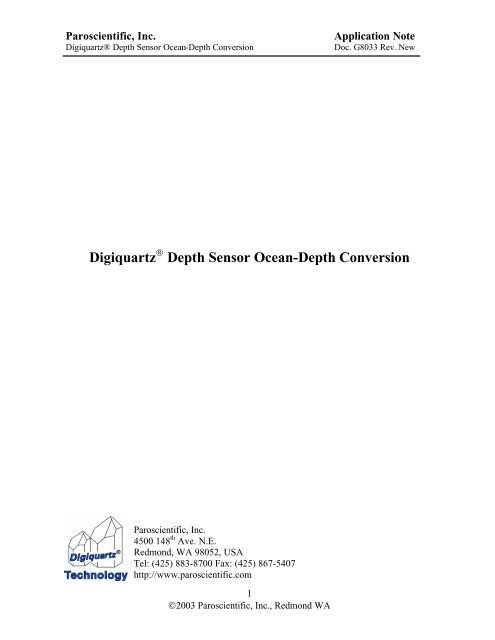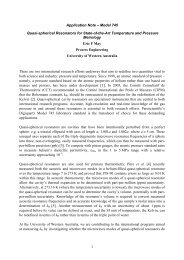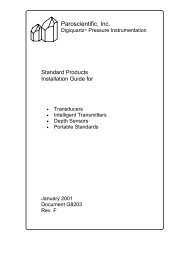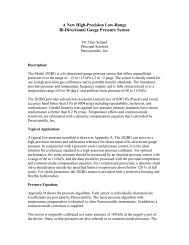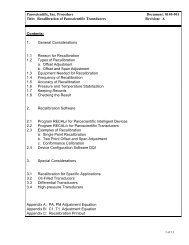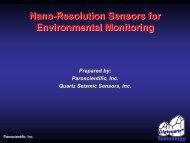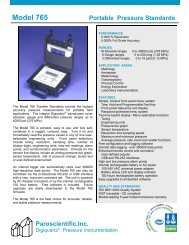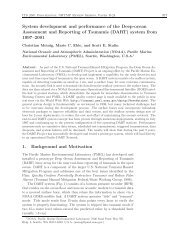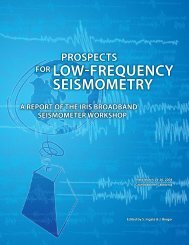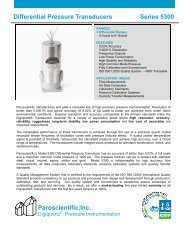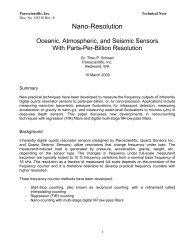Digiquartz Depth Sensor Ocean-Depth ... - Paroscientific, Inc.
Digiquartz Depth Sensor Ocean-Depth ... - Paroscientific, Inc.
Digiquartz Depth Sensor Ocean-Depth ... - Paroscientific, Inc.
- No tags were found...
Create successful ePaper yourself
Turn your PDF publications into a flip-book with our unique Google optimized e-Paper software.
<strong>Paroscientific</strong>, <strong>Inc</strong>.<strong>Digiquartz</strong>® <strong>Depth</strong> <strong>Sensor</strong> <strong>Ocean</strong>-<strong>Depth</strong> ConversionApplication NoteDoc. G8033 Rev. New<strong>Digiquartz</strong> <strong>Depth</strong> <strong>Sensor</strong> <strong>Ocean</strong>-<strong>Depth</strong> Conversion<strong>Paroscientific</strong>, <strong>Inc</strong>.4500 148 th Ave. N.E.Redmond, WA 98052, USATel: (425) 883-8700 Fax: (425) 867-5407http://www.paroscientific.com1©2003 <strong>Paroscientific</strong>, <strong>Inc</strong>., Redmond WA
<strong>Paroscientific</strong>, <strong>Inc</strong>.<strong>Digiquartz</strong>® <strong>Depth</strong> <strong>Sensor</strong> <strong>Ocean</strong>-<strong>Depth</strong> ConversionApplication NoteDoc. G8033 Rev. New<strong>Digiquartz</strong> ® <strong>Depth</strong> <strong>Sensor</strong><strong>Ocean</strong>-<strong>Depth</strong> ConversionDr. Theo Schaad16 October 2003This application note provides practical information for determining the linear depth in seawater from hydrostatic pressure measurements. It is recommended to measure hydrostaticpressure in pressure units of [decibar], which is about 1 [meter] of depth, using a <strong>Digiquartz</strong> ®<strong>Depth</strong> <strong>Sensor</strong>. A computer program in the data acquisition system is needed to perform theconversion in real-time, or alternatively, a spreadsheet can be used to convert pressure valuesto linear depth offline. For added clarity, engineering units are shown in [brackets].The standard ocean depth formula (see Unesco reference below) is:z = D/where z is depth in [meter], D is the geopotential distance fitted to a fourth order polynomialin pressure, and is the average gravity.D = C 1 P + C 2 P 2 + C 3 P 3 + C 4 P 4 = g(θ) + ½ γ PParameter Value UnitsP Measured gauge pressure [decibar]C 1 9.72659 [J/kg/decibar]C 2 -2.2512 E-5 [J/kg/decibar 2 ]C 3 2.279 E-10 [J/kg/decibar 3 ]C 4 -1.82 E-15 [J/kg/decibar 4 ]g(q) Local gravity at latitude θ [m/s 2 ] - see formula belowg 2.226 E-6 [m/s 2 /decibar]The standard ocean depth formula is derived using a water density profile at a salinity S = 35,a temperature T = 0 [deg C], and a compressibility correction of second order.2©2003 <strong>Paroscientific</strong>, <strong>Inc</strong>., Redmond WA
<strong>Paroscientific</strong>, <strong>Inc</strong>.<strong>Digiquartz</strong>® <strong>Depth</strong> <strong>Sensor</strong> <strong>Ocean</strong>-<strong>Depth</strong> ConversionApplication NoteDoc. G8033 Rev. NewCheck values: (Pressure in [decibar], depth in [meter])Pressure/Latitude q = 0 [deg] q = 30 [deg] q = 45 [deg] q = 60 [deg]500 [decibar] 496.65 [m] 496.00 495.34 494.691000 992.12 990.81 989.50 988.192000 1979.55 1976.94 1974.33 1971.725000 4915.04 4908.56 4902.08 4895.6010000 9725.47 9712.65 9699.84 9687.03Gravity varies with latitude. The standard gravity correction used in the standard ocean depthformula isg(θ) = 9.780318 (1.0 + 5.2788 E-3 sin 2 θ + 2.36 E-5 sin 4 θ) [m/s 2 ]Check values:Latitude q 0 [deg] 30 [deg] 45 [deg] 60 [deg] 90 [deg]Gravity 9.780318 9.793240 9.806190 9.819169 9.832177Gravity decreases towards the center of the earth, but the ocean and crustal densities are lowenough that it increases initially by γ = 2.226 E-6 [m/s 2 ] per [meter] (or per [decibar]equivalent pressure) of ocean depth. The ocean formulas are usually corrected for this gravitygradient by using an average gravity g = g(θ) + ½ γ P, where P is pressure depth in [decibar].The gravity gradient correction amounts to 2.8 [m] at a depth of 5000 [m].If the <strong>Digiquartz</strong> ® <strong>Depth</strong> <strong>Sensor</strong> is operated as a conventional pressure sensor, it isrecommended to convert the pressure output into pressure units of [decibar]. With anintelligent RS232/485 interface, this can be accomplished by setting the unit selection toUN=0 (user-defined units) and UF=0.6894757 (conversion from [psi] to [decibar]).Note that the pressure P is gauge pressure, which is the measured absolute pressure minus theatmospheric pressure at the surface. This can be accomplished either by a simultaneousmeasurement of surface pressure, by subtraction of a fixed value, or by taring the depth sensorat the surface. In all cases, the subtraction must be performed in the same pressure unit, e.g. in[decibar]. Standard surface pressure is 10.13 [decibar] (= 1 [atmo]) with typical weathervariations amounting to less than 0.5 [decibar]. At greater depth, the exact surface valuebecomes relatively less important and subtraction of a fixed value usually suffices. An in-situtaring of barometric pressure is possible with a measurement of the surface pressure using thedepth sensor at the surface before deployment. The surface value must then be subtracted forsubsequent depth measurements. Care should be taken that the sensor is operationally cooleddown to the ocean water and in the orientation of deployment during taring.References:Fofonoff, N.P. and R.C.Millard (1983) Algorithms for Computations of FundamentalProperties of Seawater, Unesco Technical Papers in Marine Science 44.3©2003 <strong>Paroscientific</strong>, <strong>Inc</strong>., Redmond WA


